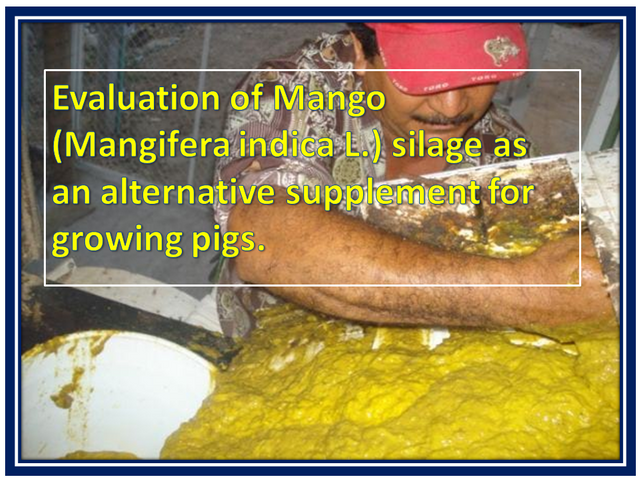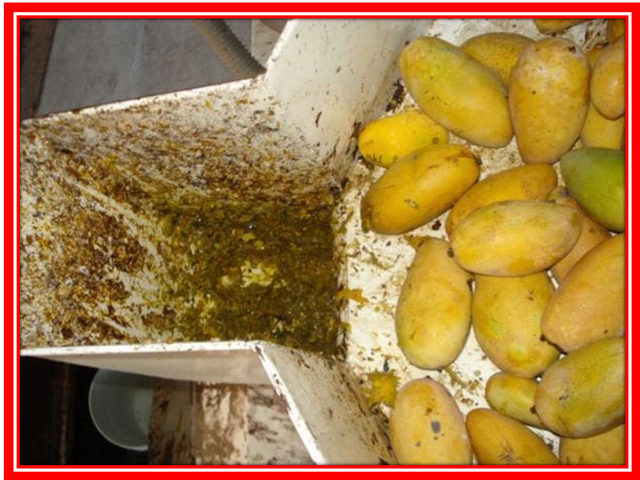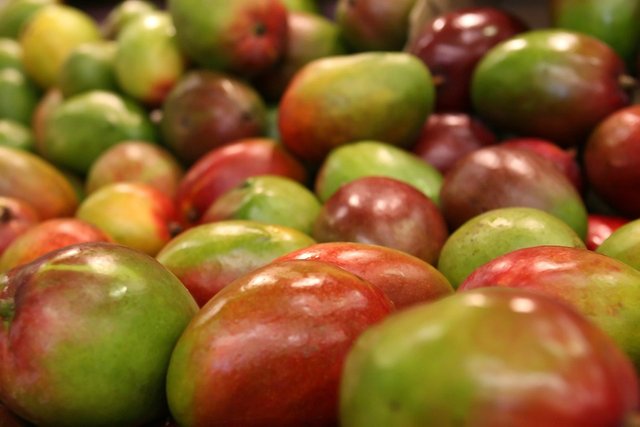Evaluation of Mango (Mangifera indica L.) silage as an alternative supplement for growing pigs.
Written by:Diomer Antonio Galán Rincón.
Bachelor's Degree.Public Accounting / MSc.Science of Higher Education.

Autor: @dgalan, a través de la herramienta Power Point 2010, y utilizando la imagen de dominio público engormix.com/
Pig production worldwide in recent decades has increased production volumes, accompanied in many countries, by the application of increasingly sophisticated technologies and silage has been an alternative that has helped in the development and growth of the swine market.
Silage is the fermentation of soluble carbohydrates from forage, fruits and vegetables, among other alternatives, by means of bacteria producing lactic acid in anaerobic conditions, achieving a final product, which is the conservation of the nutrient food, since the acidification of the medium disables the creation and development of microorganisms.
According to Jiménez and Moreno, (2003) silage "is a process used to store feed in times of harvest and supply it in times of scarcity, preserving quality and palatability at low cost, allowing to increase the number of animals per hectare or the substitution or supplementation of concentrates".

Autor: @dgalan, a través de la herramienta Power Point 2010, y utilizando la imagen de dominio público engormix.com/
This type of feed is used to manage animals in intensive, semi-intensive or stabled form. Therefore, silage is presented as an excellent nutritional alternative for the sustenance of pig farms in the country, due to the large amount of by-products or crop products, especially mango.
In Venezuela, more than half of the corn and other cereals used for the production of animal concentrates, especially for pigs, are imported, making it a costly feeding system for the pig farmer, making silage a more economical way of feeding that can meet the nutritional requirements of the animal.
Cases such as mango silage and other high-protein and high-energy fruit crops can become an economical alternative for pig farmers, giving the animals more body volume and higher monthly weight gain.

Image taken from:Pixabay
Some types of silage or storage:
According to Pahlow and Weissbach, (2006). Silage is stored in a structure called a silo. The capacity of the silo is determined according to the needs (herd size and number of rations).
* Pile silo: It is a pile covered and sealed with plastic and then with soil or other materials.
* Trench silo: It is a trench covered with plastic and then with a layer of soil, it must have a gutter for rainwater runoff. Its dimensions are calculated to establish a depth that guarantees a minimum exposure of the silage to the air.
* Tower silo: Storage towers with independent filling and unloading areas.
* Canadian silo: It is a combination of the pile and trench silo. The pile is made and covered with plastic and earth, and sealed laterally with mud..
In conclusion, we can say that in Venezuela there are few precedents in the use of mango residues, not so in other countries, where residues generated in mango processing are used, as well as discarded ripe fruits, which have no value for human food but do have value for animal feed, but are currently being used as a fodder alternative and have been shown to have the nutritional elements necessary for the development and growth of pigs.
I hope you like my article and I would appreciate all your comments.
bibliography consulted:

hello @dgalan,
this article is quite interesting because in Venezuela only in small towns mango is used to feed pigs, with a silage technique of such a common fruit mango could impact very positively on the finances of pig farmers, I think they have everything in the country so that this technique could be of great help to thousands of producers, who now struggle with the high prices of concentrated food for their animals.
Greetings @ trabajosdelsiglo
There is no doubt that this alternative will help pig farmers a lot, besides it is a successful technique in terms of nutrients and competes with the food production companies, I am sure that if the producers' organizations are organized, it will lower the inflationary prices of private companies a lot.
Thank you very much for your comments
Greetings @ trabajosdelsiglo
There is no doubt that this alternative will help pig farmers a lot, besides it is a successful technique in terms of nutrients and competes with the food production companies, I am sure that if the producers' organizations are organized, it will lower the inflationary prices of private companies a lot.
Thank you very much for your comments
Hello @dgalan, I did not know that mango could be used as food for raising and fattening pigs, I think then that Venezuela is privileged with the large production of mangoes sporadically and at the farm level, however I think that this alternative should be industrialized on a large scale although it could There may be some difficulty at the time that there is no mango harvest, is just what I think at the moment.
Greetings @ tocho2
Venezuela is a privileged country for many factors but I think we have not been able to take advantage of all the benefits it offers us, Mango silage is beginning to produce as an alternative feed for pigs, so say the producers, however I think it is not an alternative, it is a reality that must be transformed to begin to get rid of the large marketers of pig feed, because it is proven that it gives great nutrition to them.
Thank you very much for your comments
An interesting alternative for pig feeding, I did not know about the silage process and that fruits such as mango could be used for it, which seems to me an excellent option for Venezuelan producers because in this region it is easy to grow this fruit, so they could have a very good and economical alternative for raising pigs.
Greetings @ emiliomoron
The mango silage is an excellent nutritional alternative that has been implemented by pig farmers with excellent results, this helped to lower feed costs by buying concentrated feed, however silage gives a lot of nutrients without lowering the production of kilos per day of pigs, certainly the variety of types of silage is helping the sector by the crisis facing the country, this alternative is breaking the monopoly of companies that sell food.
Thank you very much for your comments.
Greetings my dear friend @dgalan, silage is a great alternative for animal feed in critical times, as you mention in your article generally cereals such as corn are used, this alternative that you show us is very good considering that we are in a tropical region and the mango crop is very well established in our climatic conditions, the use of our local resources will always be our best alternatives and achieve sustainability of agribusiness system.
See you later my friend, have a great weekend.
Greetings @ amestyj
There should be some research policies by the Ministry of Agriculture and land, however that inictivas ahna been given by the breeders in search of alternative feed, as you mention, should be exploited much more, taking advantage of the excellent benefits of the region.
Thank you very much for your comments
This is an interesting topic. I would have never realized by myself that mango could be used to grow pigs or any other kind of cattle.
And i say this is interesting because, as far as i know, there are dozens of mango varieties all across the country making it an stable, cheap and secure source of food for livestock.
Greetings @ bostonblake
Undoubtedly not only mango, there are other items that serve equally well for feeding pigs, but the mango has shown that it gives a lot of nutrients or less cost than concentrated feed and we must take advantage of it.
Thank you very much for your comments.
early this morning i've read about... PLANTAINS! yeah, plantains are also used to feed pigs and cattle. I'm pretty amazed and amused at the same time.
Greetings @ bostonblake
There are a variety of silage, including corn, that can be used as alternative feed.
Thank you very much for your comments